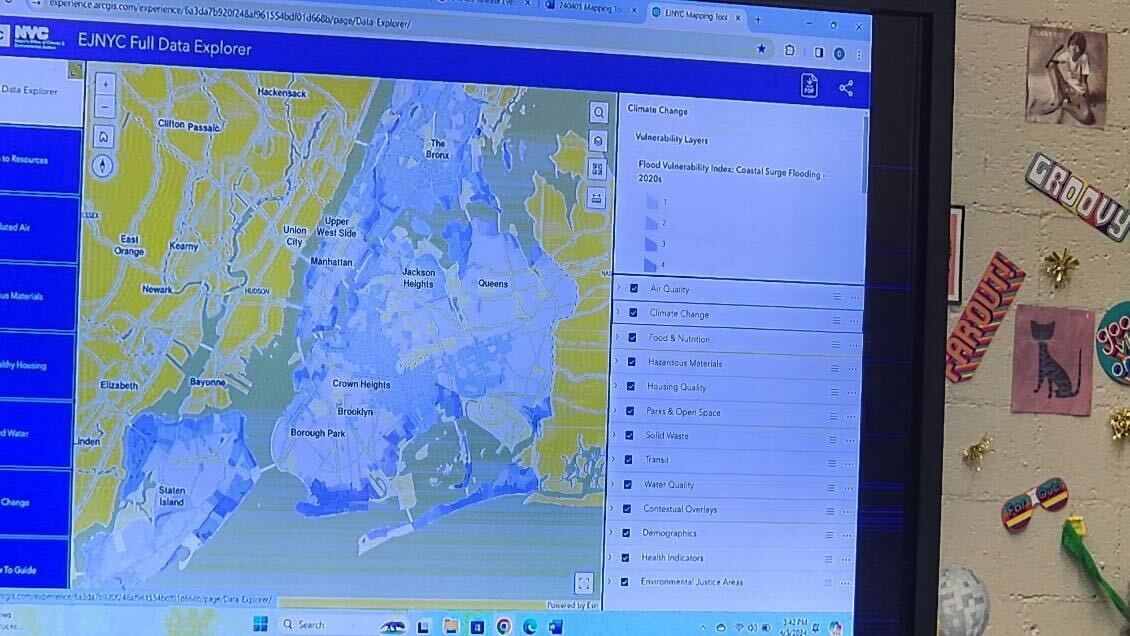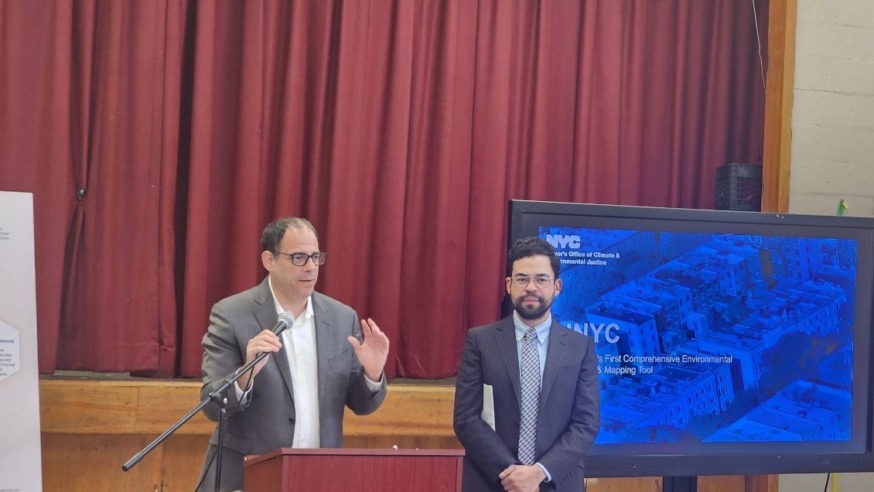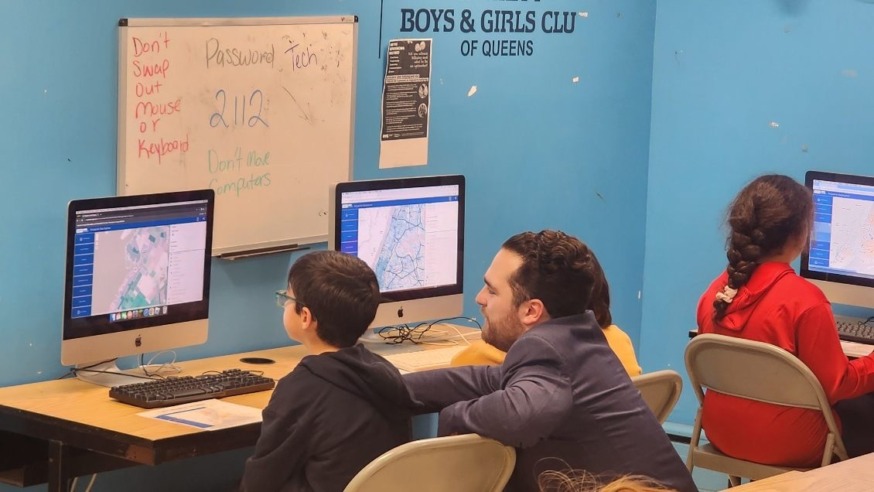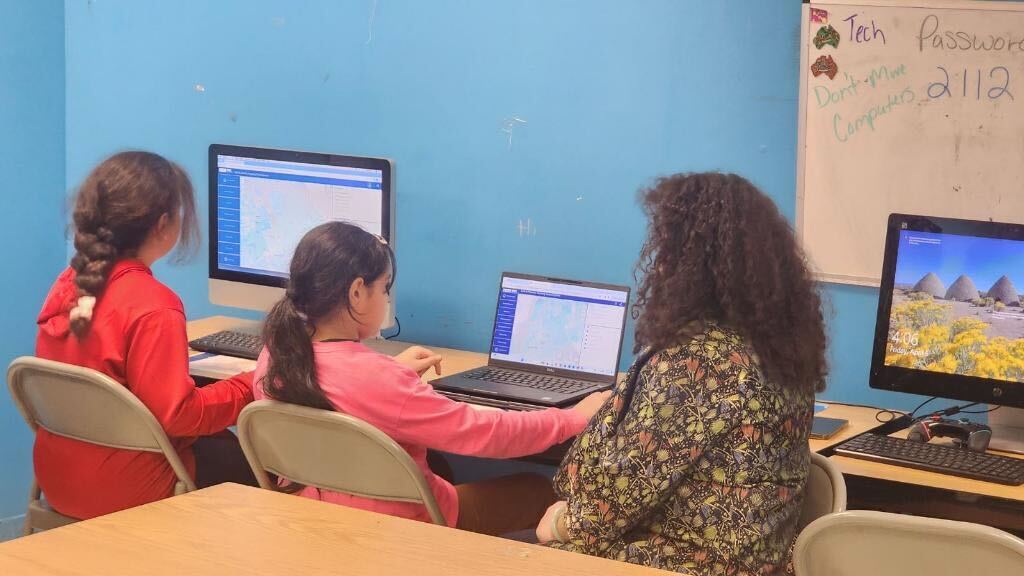
Photo by Seán Ó Briain
Apr. 8, 2024 By Seán Ó Briain
The Mayor’s Office of Climate and Environmental Justice has launched a new interactive map detailing hazards in each neighborhood in the city in a bid to tackle environmental inequity across the five boroughs.
The Environmental Justice NYC (EJNYC) Mapping Tool, the first-ever online resource of its kind, was launched at the Variety Boys and Girls Club in Astoria Friday, Apr. 5.
The Mayor’s Office also released its EJNYC report at the launch, the first-ever comprehensive study of systemic environmental inequity across the five boroughs of Manhattan.
Elijah Hutchinson, Executive Director of the Mayor’s Office of Climate and Environmental Justice, said Friday that marginalized communities are more likely to be affected by climate change, stating that black people are twice as likely to die from heat-related illnesses as white people.
He added that the new EJNYC report has highlighted that stationary sources of pollution, including water processing facilities, hazardous waste generators and peaker power plants – plants used during times of high demand – are disproportionately located in underprivileged areas called Environmental Justice areas.
“Communities of color are disproportionately exposed to emissions from heavy duty vehicles compared to communities that are mostly white,” Hutchinson said Friday. “We know these vehicles harm people’s health. EJ areas have the greatest level of pollution-attributable emergency department visits in our hospitals.
“68 percent of existing and planned last mile distribution centers or e-commerce facilities are also located in Environmental Justice communities. And environmental justice communities have greater exposure to flooding due to coastal storm surge, chronic tidal flooding, and extreme rainfall.”
Despite noting that the report was deeply concerning, Hutchinson said it was an “exciting” day for environmental justice in New York City, stating that communities and advocates will now be able to see the types of hazards affecting their neighborhoods, allowing them to advocate for measures to help combat climate change in their area.
Furthermore, he said the Office of Climate & Environmental Justice will be working closely with the City’s Environmental Justice Advisory Board in the coming months to develop policies that will address environmental hazards.
“The report and the tool are for you. They are designed to empower New Yorkers. A mapping tool can empower community-based organizations that may be operating on a shoestring budget with a handful of non-paid staff to advocate for the best outcomes for their neighborhood.”
Hutchinson added that the Mayor’s Office will be releasing the first-ever climate budget for a major US city.
“This is going to allow us to embed environmental justice and climate considerations within our budgeting decisions. and will be updated regularly and released as part of the city’s regular budgeting processes.”
Hutchinson said the climate budget will be released in April and will evaluate budgeting and spending decisions in the context of New York City’s fight against climate change.
He said the first-ever climate budget, which is part of the Executive Budget, will highlight what the city is spending to decarbonize public infrastructure and phase out fossil fuels.
Hutchinson also said the mapping tool will constantly be updated to reflect new information, enabling advocates and policy-makers alike to make informed decisions.
Peggy Shepard, the Executive Director of WE ACT for Environmental Justice, who worked closely with the Mayor’s Office on the development of the new mapping tool, described the new report and interactive moment as a “milestone moment” for environmental justice in New York City.
“When I first started campaigning for environmental justice 36 years ago, one of our goals was to ensure that environmental justice was on the city’s agenda, that our leaders understood the disproportionate burdens that our communities face, and that that they would be willing to work together toward equitable solutions to really address those disparities,” Shepard said.
Shepard, who is also chair of New York’s Environmental Justice Advisory Board, said the report and mapping tool will ensure that environmental justice is on the City’s agenda, adding that it allow officials to understand the disproportionate burdens that some communities are facing.
“We’re all eager to enter the next phase, which is developing a comprehensive citywide plan to address the environmental justice issues that are identified in the report.”

Photo by Seán Ó Briain
Meanwhile, Chief Executive of Variety Boys and Girls Club Costa Constantinides, a former City Council Member who sponsored legislation that created the Environmental Justice Advisory Board and called for the creation of the report, said it was critically important for communities to understand the issues affecting them.
“This was about getting data and understanding what’s going on in each neighborhood,” Constantinides said. “This is drawing maps and saying; ‘this is what’s happening in neighborhoods, these are things that have to be worked on’.”
Constantinides said the interactive map will help officials to come up with “concrete plans” to reconcile environmental injustices across New York City.
Pointing to his native Astoria, Constantinides said 25% of New York’s power comes from power stations located between the East River and 21st Street, adding that there are higher rates of asthma in that area than anywhere else in Queens.
He said Environmental Justice areas have been “dumping grounds” for hazardous developments for too long.
“Whether it’s wastewater treatment plants, waste transfer stations, or power plants, these are things that have been dropped into communities.”
Constantinides added that different neighborhoods are dealing with different problems and that the interactive map allows officials, residents, and community groups to identify issues affecting a particular neighborhood and come up with solutions.
“As a former elected official, understanding what’s happening is the first step,” he added. “You can’t solve a problem if you can’t identify what the problem is,” Constantinides said, adding that he hopes the interactive map helps inspire local advocacy.
Friday’s event concluded with a group of students at the Variety Club learning how to use the new interactive mapping tool, with children encouraged to teach their parents and friends how to use the new map.

Photo by Seán Ó Briain

Photo by Seán Ó Briain






